► Peugeot’s back at Le Mans
► It’s got a history of winning
► Can the new 9X8 keep it up?
When it puts its mind to it, Peugeot wins Le Mans – the beautiful 905 and brutal 908 are testament to that. Can the stunning new hybrid 9X8 honour their legacy?
Let’s dig deep into Peugeot’s history as a famed Le Mans competitor…
1992 905B Evo 1 Bis: Todt’s V10 tearjerker
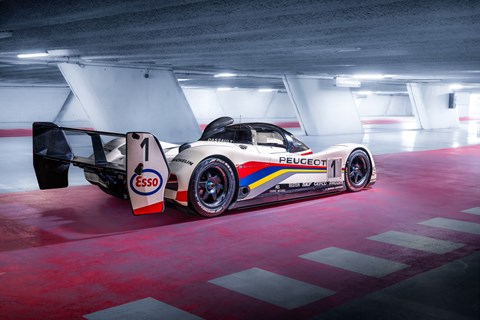
Created in the dying days of the Group C era to compete under the FIA’s then-new 3.5-litre regulations, the 905 started life neither beautiful nor fit to challenge at Le Mans. But by 1992 it was both, the elegant V10-engined machine winning at Silverstone, Le Mans and Suzuka on its way to glory in the 40th and final running of the FIA World Sportscar Championship. The car recorded a second win at Le Mans the following year, and with that the architect of its success – Peugeot Talbot Sport lynchpin Jean Todt (you may have heard of him) – headed to Maranello to build a new empire in scarlet.
Remarkably, the 905 was created by a team with no prior circuit racing experience. While Peugeot Talbot Sport’s Group B 205 T16 had won rallies, bagged drivers’ and manufacturers’ titles and conquered the Dakar (twice), it and the later 405 (of Pikes Peak legend) taught their maker next to nothing about the fine art of sportscar racing. Work on the 905 began in 1988 and Todt, acknowledging the paucity of relevant experience in his 120-strong Vélizy-based equipe, hired himself something of an A-Team. Under technical director André de Cortanze (formerly of Alpine and Renault), Robert Choulet (whose CV included the long-tail Porsche 917) sculpted the 905’s body and monocoque while French plane manufacturer Dassault was approached to craft these structures in light, stiff and impact-shrugging carbonfibre. Engine Jedi Jean-Pierre Boudy, who’d worked on Renault’s successful V6 turbo F1 programme, was tasked with creating the V10: an all-aluminium, 40-valve masterpiece initially rated at a very conservative 600bhp at 12,000rpm… It’d ultimately make nearer 650bhp.
The 905 debuted in 1991. It won races but Le Mans was a disaster, the team battling fuel fires, electrical issues and gearbox failures. The car lacked long-distance development, and both 905s were parked up by dusk.
Cue the montage. The 905’s carbon hull was retained but the bodywork much modified for ’92, with a lower, stubbier nose shrouding tightly packaged suspension. Ducts on either side of the bubble cockpit fed radiators in sidepods outboard of vast venturis. The engine cover was lowered, for a cleaner airflow onto the enormous biplane rear wing, and the engine made both tougher and more powerful. The gearbox, too, was upgraded (new pinions and revised lubrication) in the light of Peugeot’s simulations, which figured a 24-hour race would require no fewer than 18,000 shifts…
Todt, already convinced that a great car is nothing without a great driver, also went in search of top-tier helmsmen.
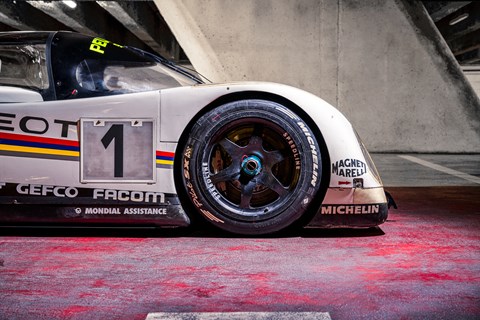
‘At the end of ’85 I’d signed for Lotus, to be Senna’s team-mate,’ explains Derek Warwick, who was right at the top of Todt’s hit list. ‘But Ayrton made them tear up the contract, so come December ’85 I was without a drive. I raced a [Porsche] 962 at Daytona [to third place] and I loved it. F1 is another level, don’t get me wrong, but I loved sportscar racing. From there I raced for Jaguar in ’86, in the XJR-6, and again in ’91, in the XJR-14, which was a purebred racing car – an F1 car with bodywork; simple as that.’
Todt called in late ’91. ‘He wanted me to be the lead driver in one of his cars for ’92: Philippe Alliot, Mauro Baldi and Jean-Pierre Jabouille in one; me, Mark Blundell and Yannick Dalmas in the other,’ recalls Warwick. ‘We met in Paris, talked money and I left in a huff, playing the old poker game. But we stayed in touch, Jaguar wasn’t sure of its plans for ’92, Ross Brawn left [for Benetton in F1] and Jean got serious. I signed and we started testing – full 24-hour tests at Paul Ricard [with chicanes on the Mistral straight to simulate those on the Mulsanne]. After two or three 24-hour tests I got to like the car a lot. The engine was good and the car was so, so beautiful. I did a lot of the testing, especially from midnight to dawn. I don’t remember seeing much of the other drivers after midnight; they liked their beds.’
Like Warwick, mechanic Laurent Guyot joined the team in January 1992. ‘Straight away you got the feeling that you were working for a big company, and that this company wanted to win; it wanted to win today, tomorrow and the day after that,’ says Guyot. ‘I remember my job interview with Jean Todt like it was yesterday. He is an amazing guy. There was a unique atmosphere inside the team – we knew we were there to win.’
Come June ’92 the 905 was at last beautiful and ready to challenge at Le Mans. Metronomically reliable, it was also 14 seconds a lap faster than the ’91 905 and four seconds a lap faster than the ’92 Toyota…
‘In ’92 we did a better job [than the sister car] setting up for the race,’ says Warwick. ‘That helped us save fuel. We were a little slower but we were friends with the car; kinder to it. And every time we swapped drivers we’d yell “Gearbox!” at each other, just to remind the new guy to look after it.’
After an early dogfight between Peugeot, Mazda and Toyota, the number 1 905 set about building a lead. Through the dead of night, as rain lashed the La Sarthe circuit, the Peugeot stayed ahead.
‘It was hard work,’ says Warwick. ‘In the middle of the night someone tugged my arm and told me we were running way off the pace. I turfed Mark out, got back in and did a triple stint. I was good in the wet, and the engine was great – it made good power but it wasn’t peaky.’
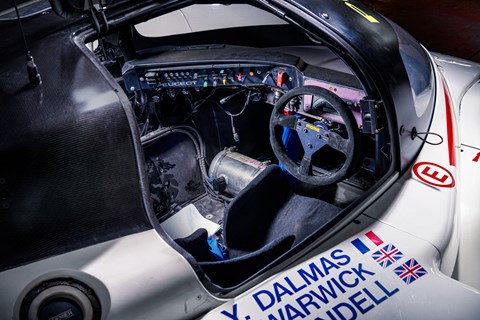
Sunday morning and, bar a troublesome ignition module (the control unit and battery were swapped in a 12-minute stop), Warwick’s 905 was still out front. It went on to win, six laps ahead of the Toyota in second.
‘With half an hour to go Yannick was in the car, which was the ideal situation – a French driver winning a French race in a French car,’ says Warwick. ‘But Jean pulled the car in and gave me that last half an hour. I’d lost my little brother the previous year and it had a massive effect on me. [Paul Warwick lost his life leading an F3000 race at Oulton Park in 1991.] Emotionally I was pretty drained. Jean picked up on this. He would ask me about Paul and he knew how important it was for me to do something spectacular – something to remember Paul by. He brought the car in and let me finish the race. Jean knew how much work I’d put in. I’d driven the car more than anybody in testing and this was my reward. As the clock ticked down I was so emotional; so, so happy. I remember coming on the radio down the Mulsanne and yelling, “Problem! Problem! The car’s stopping!” It wasn’t, but I was belly-laughing at the thought of the team running around going, “Fck! Fck! Fck!” Afterwards I thought, “Derek, don’t tempt fate for fck’s sake.” Of all the cars I raced the 905 stands out – everything about it was just gorgeous.’
‘I remember the race as a series of snapshots,’ says mechanic Guyot. ‘One of them was the first pitstop – us waiting and the car coming down the pitlane. I can see that moment now so clearly, me waiting with my wheel gun to change the front-left wheel. We weren’t nervous. We knew that what we were doing was important but we were ready and we were focused. It was magical when we won. For me, the 905 is more than just a racing car. It’s special. Even today – not everyday but sometimes – I only have to hear the noise of the 905 and, yeah, I get pretty emotional.’
1992 Peugeot 905B
Powertrain 3499cc 40v naturally-aspirated 80° V10, six-speed sequential manual, rear-wheel drive
Performance 640bhp @ 12,500rpm
Weight 750kg
Glory Eight World Sportscar wins from 14 races (1991-1992) including two at Le Mans
2009 908 HDi FAP: a natural born winner
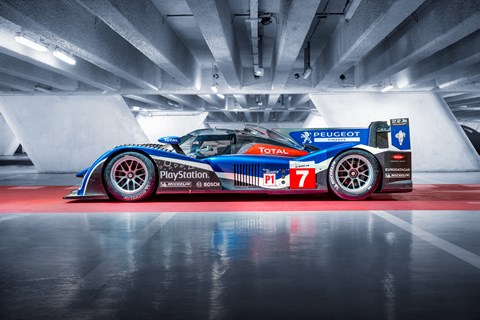
To understand just how good a car the 908 was, one must first understand the enormity of the challenge it faced. Audi first contested Le Mans in 1999, its open-cockpit R8Rs coming home third and fourth. The R8 arrived in 2000, and so began an era of startling dominance: four wins from five races 2000-2005 and, with the turbodiesel R10, further glory in 2006, 2007 and 2008. In this period Audi owned Le Mans; it was Le Mans.
Enter the disrupter.
Peugeot unveiled the 908 in 2005. Race engineer Christian Deltombe joined the team in late 2006, just as the 908 programme was shifting from the design and engineering phase to the grubbier, more visceral business of readying a competitive race car.
‘There were some people with knowledge from the 905 still in the team but not many, so in 2006 and 2007 we were building the team at the same time as we were building the car,’ explains Deltombe, who’s back with Peugeot now on the 9X8 programme. ‘I was really happy in terms of the people we had and the philosophy. There was a feeling in the first couple of years of the team slowly gathering its strength, step by step. But after Monza we really started to believe we could win Le Mans again.’
The 908 debuted in the 2007 1000km of Monza, setting a searing pace in qualifying and winning the race. A stream of victories followed through 2007 and 2008, the Peugeot time and again demonstrating its inherent speed, efficiency and (mostly) strong reliability.
Like the R10 Audi, its main rival initially, the 908 used a 5.5-litre twin-turbo diesel V12 (its cylinder banks splayed at 100° to lower the engine’s centre of gravity) good for more than 700bhp and 900lb ft of torque. But unlike the R10 the 908 ushered in a new era of closed-cockpit sports prototypes (bar the Bentley, open-cockpit cars had reigned since the late ’90s), Peugeot rightly figuring that the operational hassle of doors would be more than offset by increased chassis rigidity and superior aero.
‘The closed-cockpit decision was born of two targets: safety for the drivers and aerodynamic efficiency,’ explains engineer François Coudrain, who worked on the 908. ‘It was a Peugeot decision, as was the turbodiesel engine. The diesel engine was not dictated by Audi. Peugeot had a major diesel strategy [in the wider business] at the time with the particulate filter [the FAP in the car’s full name]. For Peugeot the stars aligned with the 908; the decision to go into competition, the diesel strategy of Peugeot and the regulations, which were open to diesels.
‘The diesel engine was incredible in terms of torque – for the drivers, it hit them when they left the pits and deactivated the pitlane speed limiter,’ continues Coudrain. ‘Also, the aero regulations were very open, so we were able to create a very efficient car into which the diesel powertrain was integrated completely. The main challenge was maximising performance while optimising the weight and the centre of gravity. This was not easy – to have power without making the engine too heavy.’
The V12’s titanic torque made the 908 a fearsome challenge for its race engineers and drivers. ‘For the technical department it was a challenge for sure, and for the gearbox also, because the torque was very high,’ explains race engineer Deltombe. ‘For us the torque complicated the traction control and tyre management. The diesel engine was also not light, and it shifted the weight distribution [rearward], which again did not help the rear tyres. But the 908 was a nice package; responsive to set-up, efficient and fast.’
Le Mans glory eluded the 908 for two years. But in 2009 Peugeot was again victorious in the world’s greatest race, 16 years after the 905’s swansong. Former F1 pilot and active Mercedes-AMG simulator driver Anthony Davidson tested the 2009 908. He was blown away by just how good a car the turbodiesel Peugeot was.
‘Of all the cars I’ve raced the 908 suited my driving style the most,’ says Davidson. ‘I could dominate it, feel brilliant in it and do great lap times every time I drove it. F1 spoils you, and the touring cars and GT cars I’d driven just didn’t come close. But the 908 was different. Yes, it was heavier than an F1 car but it didn’t require a completely different skill set. I could drive it like an F1 car full of fuel plus a bit more.’
Not only did the 908 feel like an F1 car, it shrunk racetracks with a comparable combination of low weight, huge downforce and monstrous speed. ‘It had slightly less power but the diesel V12 was silky smooth and it had loads of torque; way more than an F1 car,’ remembers Davidson. ‘Back then an F1 car made peak torque at 17,000rpm. The 908 was delivering something like 920lb ft at 3500rpm! Unbelievable. [Ferrari’s ferocious SF90 hybrid develops a combined 590lb ft of torque…] You could be in any gear and it’d just pull. The 908 was just an absolute joy to drive. I loved it.’
Davidson joined Peugeot for 2010, driving a lightly revised V12 908. It was an opportunity he relished. The car might have been designed for him, so sweetly did it dovetail with his F1-derived driving style, and the team was fired with a passion the likes of which he hadn’t seen before.
‘You’re used to the standards at which F1 operates,’ says Davidson. ‘You question whether any other category will come close. But Peugeot Sport was an incredibly professional outfit and I loved their emotion. It was very raw; very French. For a stiff-upper-lip Brit it was a joy to be a part of. They were just so dedicated to the spirit of endurance racing.’
2009 Peugeot 908
Powertrain 5486cc 48v twin-turbo diesel 100° V12, six-speed sequential, rear-wheel drive
Performance 730bhp @ 6000rpm, 920lb ft @ 3500rpm
Weight 930kg (including 30kg of ballast)
Glory 20 wins from 30 races including one Le Mans win (2009)
9X8: once more unto the breach
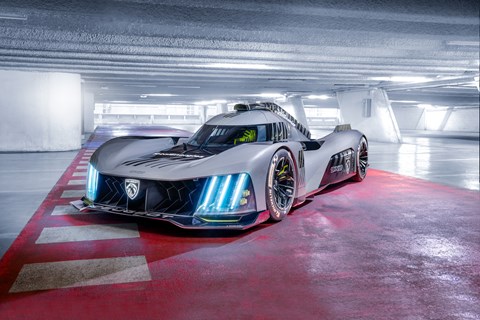
The story of the diesel 908 has a not-all-that-secret Easter egg of a secret ending. Locked in a titanic struggle for supremacy with Audi, Peugeot continued to develop the car at a furious rate. For 2011 a 3.7-litre V8 replaced the big V12, trading perhaps 150bhp for increased agility, efficiency and speed over a race distance. Audi claimed the big prize, Le Mans, but Peugeot won five of seven races to secure the LMP1 manufacturers’ cup, the precursor to the World Endurance Championship. And for 2012 Peugeot readied an experimental diesel-electric hybrid 908, the HYbrid4. It was to battle Audi’s upgraded R18 alongside a couple of non-hybrid V8 908s.
‘Development of the hybrid 908 began in 2011, and the plan was to debut the car at Sebring in 2012,’ explains François Coudrain, who worked across the 908’s V12, V8 and hybrid programmes. ‘By 2012 the development work was complete. We’d validated the car in testing. It was ready to race.’
Imagine the shock, then, when Peugeot announced its immediate withdrawal from the sport just weeks ahead of Sebring. ‘This decision has been taken in the context of a difficult economic environment in Europe,’ read a statement issued on 18 January, deadline day for the registration of entries for the 2012 season.
The team was heartbroken, as was driver Anthony Davidson. ‘I felt robbed,’ he says. ‘I felt sad that the programme ended so soon and so abruptly, and it was a real shame we never got to try the hybrid package. It was set to be a pretty phenomenal car, one that would have pushed the boundaries of hybrid technology [LMP1 really embraced hybridisation a few years later, with Toyota, Audi, Porsche and Nissan all developing petrol-electric hybrids]. But this is the double-edged sword of manufacturers in motorsport. You really need them, and their presence always raises the bar. But you always know it’s for a finite amount of time, and that they can pull the plug, sometimes for reasons that have nothing to do with racing, at any time. Often it’s a decision from the marketing side, or from the board of directors. From a corporate point of view it may make sense to them but as true racers you have to live through it. It’s like Honda in F1. They came, they left, they came back and now they’re leaving again.’
Fortunately, sportscar racing’s cycle of feast and famine is now gearing up for a few years of bacchanalian revelry. The good times – and the manufacturers – are back, drawn by the glittering prize of immortality [2023 is the big one: the 100th running of the Le Mans 24 Hours] and a set of regulations that both showcase technology relevant to global marketing and, crucially, offer something like a sustainable return on investment.
This, then, is the dawn of Peugeot’s third endurance racing age. The 905 and 908 were winners and heart-on-sleeve proud Peugeots – the jaw-dropping and ferociously sexy 9X8 is their lion-badged legacy.
The new Hypercar rules have hybrid power at their core (key to marketing, and therefore participation) and promise lap times not far off the big-money prototypes. Crucially, though, the freedom to innovate technically – and therefore the cost of entry – is reduced. There are two categories. LMH is the ‘purer’ of the two, and the one Peugeot (and Ferrari and Toyota, among others) have committed to. LMDh is the more affordable option. Audi, BMW and Porsche to name but three have decided this is the one for them. In theory cars from both classes will vie for overall honours.
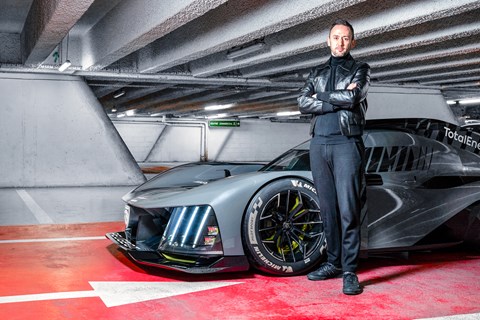
In line with the regulations, the 9X8 combines a 2.6-litre, twin-turbo 90° V6 driving the rear axle (V10, V12 and V8 turbodiesels, turbo-hybrid V6… Peugeot’s sportscar powertrain trajectory certainly reflects what Peugeot CEO Linda Jackson describes as the marque’s ‘energy transition’ to electric) with a 900-volt battery and a 268bhp front e-motor. The result is an all-wheel-drive machine with a combined output of some 670bhp.
‘The 9X8’s general powertrain architecture is dictated by the regulations, but within those we made some specific technical choices pertaining to the transmission, the battery and the internal-combustion engine,’ explains powertrain engineer Coudrain. ‘With the petrol engine the priorities were the same as the 908’s turbodiesel V12 – a low centre of gravity and complete reliability. We are happy with the performance in terms of latency [turbo lag], the weight and the power. The output and location of the electric motor/MGU [motor generator unit] is dictated by the regulations but we have a lot of control over the energy and torque management. We’re putting a lot of our focus into this software, working closely with the [DS] Formula E team, particularly on energy regeneration strategies. All the Stellantis motorsport teams are located together, working towards their own targets but sharing experience and expertise.’
In a Brutalist and brutally cold Parisian multi-story car park, the 9X8 looks little short of sensational. Comprised of bold, dynamic volumes studded with bold details, it combines much of the 905’s elemental elegance with an aggressive, space-age aesthetic appropriate for sportscar racing’s new and highly competitive hybrid era.
The echoes of 905 are no accident. ‘The 905 is one of the most iconic endurance racing cars ever,’ says design director Matthias Hossan, who joined Peugeot in 2012. ‘I asked the museum to send a 905 to our design workshop. When you see the 905’s silhouette you instantly understand the car and you remember it; it’s super-easy to identify. We tried to achieve this with the 9X8.
‘The balance of performance rules [a performance-tweaking mechanism by which the faster cars will be pegged back and the racing kept close] made it possible to design something really different,’ continues Hossan. ‘And this really was a design job, not a styling job. It was a constant collaboration with Peugeot Sport’s engineers. We’d design a form and immediately send the data over for evaluation by CFD on the computer. The aerodynamics meant it was a real challenge mentally. As designers we’re used to working on surfaces. Here we had to flip that and almost design the negative space – the shapes around the surfaces that you want the airflow to follow.
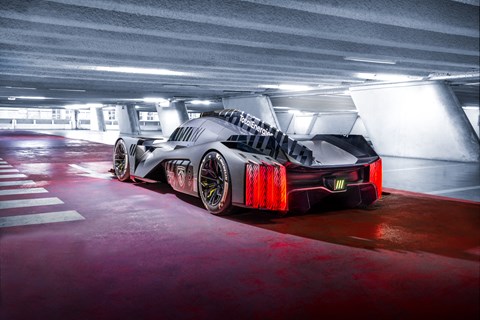
‘In terms of design the diesel 908 was all about performance – there is very little brand DNA. The 905 was both; performance and, from a design perspective, very much a Peugeot. It has that feline stance. Hopefully the 9X8 too is both. But it is not just a retro 905-inspired design. We wanted to create an optimistic vision of the future.’
There is much to be optimistic about. The team’s Le Mans track record speaks for itself, and the expertise and passion that powered the 905 and 908 to glory are undimmed. Indeed some of those working on the 9X8 now, including Guyot, Deltombe and Coudrain, were there on those triumphant Sunday afternoons years ago. Now the lion will tackle racing’s most daunting challenge once again, and dream of a prize made all the more special by the massed ranks of storied rivals hellbent on victory.
‘These new regulations will write a great new chapter for endurance racing,’ says Laurent Guyot. ‘It is too soon to say which of these Peugeots is the greatest. The 9X8 must write its story before we can judge that.’
2022 Peugeot 9X8
Powertrain 2599cc (est) twin-turbo 90° V6, seven-speed sequential, front e-motor, all-wheel drive
Performance 670bhp, (including 268bhp front e-motor)
Weight 1030kg
Glory A successful first track test in late 2021